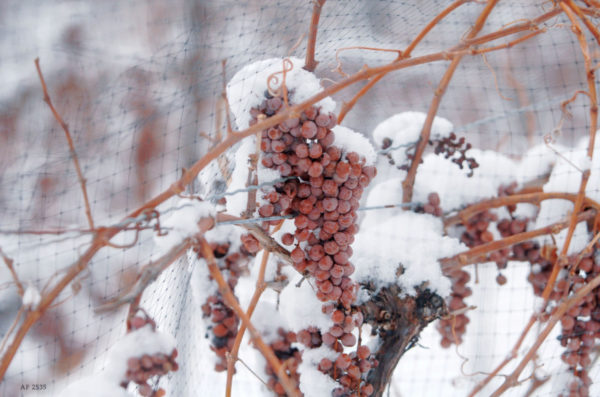Each gardener uses his own methods of sheltering grapes to protect them from frost. However, when performing work, many mistakes are allowed, which leads to the freezing of the vine or its overheating. Below in this article we will look at how to prepare the grapes for harboring for the winter, what material for this to choose and how to cover the young and mature plantings.
Table of contents
Do I need to prepare grapes for winter
Before you start preparing young grapes for winter, you should familiarize yourself with the characteristics of the variety and its features. Among the existing species are plants that are resistant to low temperatures and are very sensitive to cool. In addition, an important factor is the climate of the region where the crop is grown. On the basis of the information gathered, a plan of preparatory activities should be built.
Winter hardiness of plants indicates their ability to endure adverse weather conditions in the cold season. All varieties are classified according to this indicator in the following types:
- unstable to low temperatures (they do not withstand even frosts down to -10 °);
- unstable, able to survive the cold to -15-17 ° (with the preservation of eyes up to 100%);
- medium resistant (up to -21 °), keeping eyes up to 40-60%;
- with increased stability (up to -25-27 °) with 60–80% eyelets preserved;
- highly resistant (up to -27-28 °) with the retention of peepholes up to 80-100%.
Any grape variety should be prepared for winter, but the list of events will differ in each case. In drawing up the list of works it is worth considering that the roots are more susceptible to freezing than the vine. Likewise, the bush itself tolerates cold in different ways: the age plant possesses an increased resistance, unlike young animals.
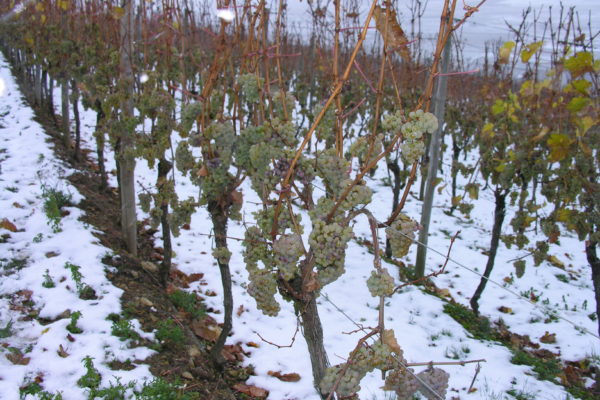
In regions with adverse climatic conditions, wrapping bushes is considered a necessity, because the indicators often drop below -30 °. Without insulation, plants can not do. Also it is necessary to provide shelter for the root system of crops growing on sandy soils, where a high percentage of vine freezing is noted.
How to protect the plant
Before we talk about when to harvest the grapes for the winter, let's talk about the preparation. At the end of the season, a series of activities are carried out aimed at restoring the vitality of the vineyard to ensure survival in conditions of frost and strong winds.
Autumn vine processing and preparation for pruning
The first thing to pay attention after collecting the clusters is the state of the vine. On the bald shrub you can easily see all the damage and lesions. The plant at this stage should be processed if even during the inspection no signs of disease or the presence of insects were detected. Spraying will help avoid the development of various infections, with the result that the bush does not stand the test in winter and dies.
You should not be afraid of chemistry, because by the time of the next season, all toxic components disintegrate and are completely removed from the soil. The future harvest will be completely safe. But to save the life of the vine without special tools will be extremely difficult, especially when it comes to mildew or oidium. Among the popular fungicides:
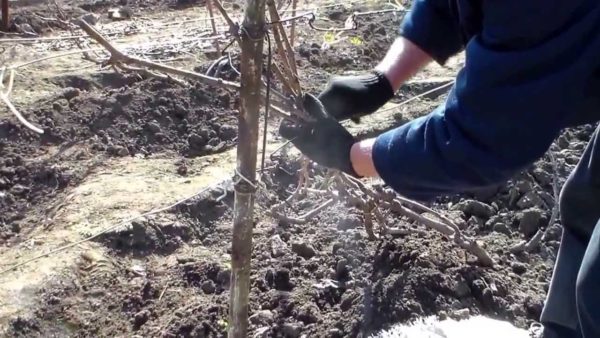
- Ridomil;
- Amistar;
- Hom;
- Fundazol et al.
Autumn spraying of plants solves several problems at the same time:
-
- enhances immunity of the culture;
- destroys the larvae, harmful microorganisms and bacteria that hide under the bark;
- localizes the lesion of infection;
- compensates for the deficiency of beneficial trace elements.
Pruning before harboring
After the foliage falls off (in a couple of weeks) they start pruning the bushes. Autumn procedure for the plant is less traumatic, because the process of moving the juice on the vine is suspended at this stage. In addition, during the winter cut will have time to stiffen.
Pruning young shoots aimed at the formation of a bush. To do this, select a specific scheme. Of the vines growing from the ground at an angle, leave 3-8 sleeves. If you perform the procedure annually, there will be no problems with pruning. But with an adult plant will have to tinker, especially if it has not previously been subjected to cleaning and thinning. Following simple rules, even the most neglected shrub can be put in order.
-
-
-
- With perennial sleeves remove young shoots that appeared at a height of up to half a meter from ground level. This should be done in the first decade of September.
- Further, the level is cut from 50 cm to 1 m from the ground surface.All young shoots need to remove the top (up to 10% of the total length). Lateral stepchildren are superfluous on the bush, they should be removed.
- In the middle of October, about when all the leaves will fall, you need to choose the most developed shoots (2-3) at a height of up to 1 m from the ground.
- The lower process, formed from the outer sleeve, cut, retaining 3-4 peepholes. Thus, we get a swirl of replacement.
- Escape, located on the opposite side, is cut with retention of 5-12 eyes. So the fruit arrow will be formed.
-
-
After such a pruning on the plant will remain only powerful perennial stumps and sleeves with buds, which in the new season will throw out young shoots and brushes.
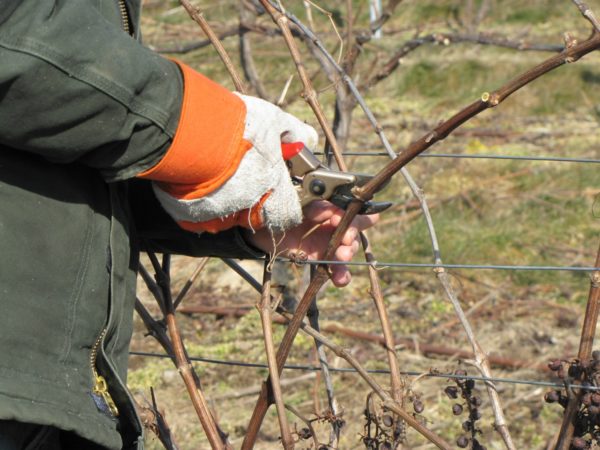
Top dressing, watering and pruning in the garden
Irrigation after harvest is carried out if necessary. It is not necessary to water the bushes with heavy rainfall. If the weather indulges with steady warm and dry weather, then it is simply necessary to soak the soil with moisture. In October, doing only one thing, but plenty of moisture. At this irrigation work is stopped until the next season.
At the end of the fruiting period, the grape bushes are completely emptied, and feeding nutrients will be very appropriate.The plant needs to gain strength for survival in the winter. In the fall, the young vine is necessarily enriched with organic matter (compost, humus, a mixture of peat and wood ash), the adult culture is fed once every 3-4 years. In feeding, it is important to observe a sense of proportion; it is better to underfeed with grapes rather than overload it with various microelements.
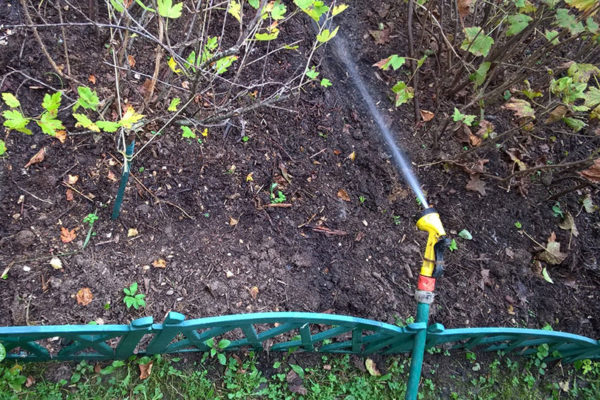
At what temperature is necessary shelter
Unsustainable grape varieties are necessarily covered for the winter period with a protective layer. The same procedure is performed with plants grown in a harsh climate. If the vine is not insulated or covered, the first frost will cause the plants to die. Annual shoots are particularly sensitive to low temperatures, therefore they are wrapped, even if the variety is frost resistant.
Terms to warm the grapes before the cold
Hurry to close the bushes is not worth it. In warm weather, grapes can stop.A wet environment often provokes the development of a fungus. But at the same time dragging is also unacceptable, because even small frosts are dangerous for unstable varieties. The optimal term for the construction of protection falls on the end of October. But to a greater degree it is worthwhile to be guided by weather conditions, only they indicate the need to speed up the process.
In the northern regions, training is planned for late September - early October. And in the southern part of the country and the middle lane, the period of preparation for winter falls at the end of October - the beginning of November. The main thing is to finish everything before the first frost.
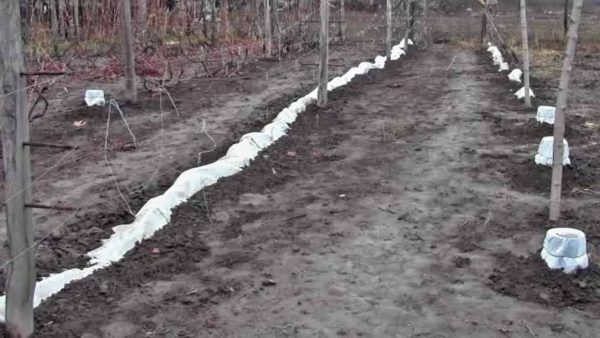
Necessary materials
Along with the usual covering materials it is recommended to use agrofibre. Thin and light tightly perfectly passes moisture, retains ultraviolet rays. When in contact with plants, there are no dangers, the composition of the agrofibre does not include toxic substances, which confirms its environmental friendliness.
Insulation will last more than one season if you fix it correctly and carefully unpack the grape whip in spring. And the main advantage is the ease of use of the canvas, it is enough to cover the vine and sprinkle everything with soil.
Along with agrofibre applied film. There are several options for creating a shelter, but they all require constant monitoring and presence. During the thaw, the film material must be opened to allow air to circulate. In the opposite case, the grapes can be planted.
The essence of the creation of the shelter is to establish a small frame of thick wire and cover it with polyethylene. This method is suitable for the regions of the middle band, where the frost does not exceed 20 °.
Spunbond refers to modern materials with thermal insulation characteristics. It is well breathable moisture. It is used both on the frame and as a wrapping cloth (like agrofibre).
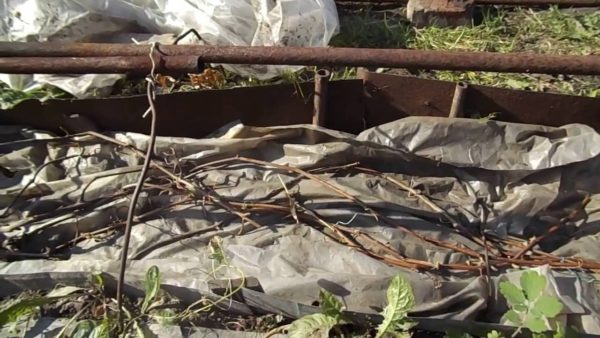
Ways to cover whips in winter
There are several ways to shelter the vine, which makes it possible to choose the best option.
Dry shelter
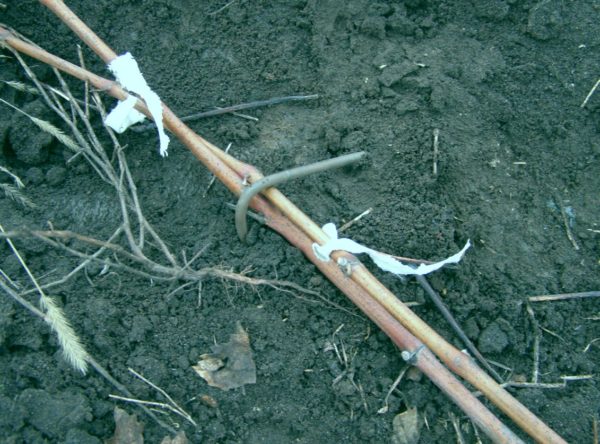
With this method, the whip is connected closer to the root zone and bends to the ground (the interval of 10-30 cm is observed). With the help of metal brackets fixed position of the vine. The lower part is abundantly filled with sawdust or dry leaves, and the surface is covered with foil. The edges are firmly reinforced with bricks or stones so that the wind does not blow away the shelter.

Partial closure
This method involves hilling bushes, and partially wrapping the material of the part that is closer to the soil. This approach is more suitable for the middle band, where frosts fall not lower than 25 °.
Ground insulation
This method is used more often than others. The bottom line is digging a trench and sinking a bound whip into it. In order not to damage the vine and avoid freezing, it is recommended to cover the branches first with boards and then prikopat soil. Layer thickness should be 20 cm.
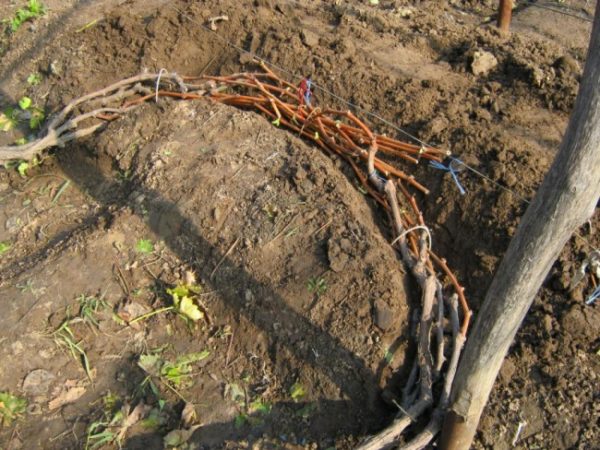
The method of using powder primer is popular due to the simplicity and the absence of additional costs for the work.
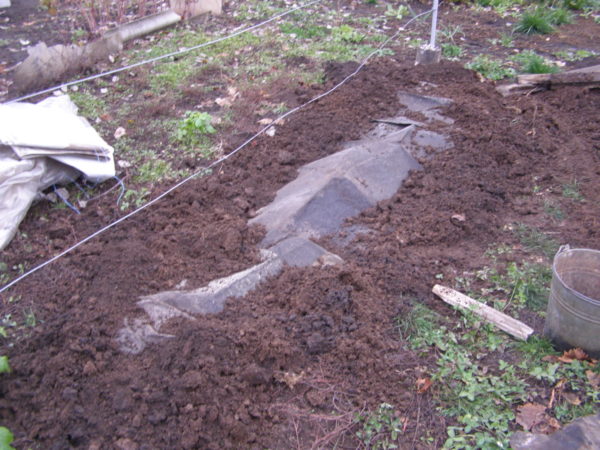
Way lodge
Covering a house is not difficult. It is also considered a low-cost measure and is used mainly in small farms. To create protection, it will be necessary to prepare guards (150x30 cm), attach loops to them from the inside and beat them with roofing material for waterproofing.
The essence of the method is to place the vine on the shield, the other two are fixed with the help of loops, forming a triangle. Roofing material is attached from the inside, preventing the penetration of precipitation on the whip. Advantages of the method: the lack of contact of branches with the soil, the air gap that has arisen between the bush and the house.
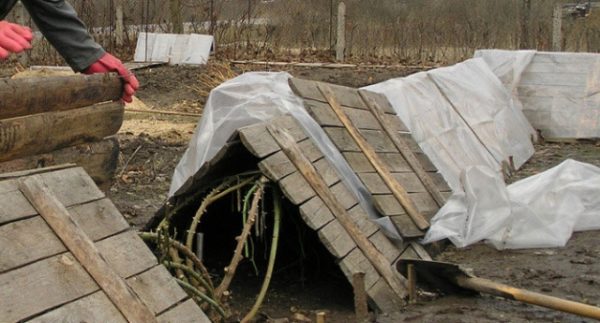
Major mistakes newbies
When carrying out the shelter of the vine, gardeners often make mistakes that can make the defense ineffective or lead to the destruction of the bush.
-
-
-
- Creating a shelter for the vine, the soil is removed from the root system of the grapes. As a result, the roots are frozen. If the lash is to be sprinkled with soil, it should be taken in a free area.
- When fixing the covering material wrapping the vine, a weak trim is made. At the first gusty winds, the protection flies off the branches, leaving the vine without insulation.Experienced gardeners recommend to install snow retention in addition to reliable tying of the vine - boards made of wood or iron, installed with a peg around a bush.
- Carried away by the warming of the vine, many forget about the roots, and they are most vulnerable to low temperatures. Therefore, you need to podgresti soil under a bush, pour dry leaves or peat.
- Before creating a shelter bush does not pass processing. Under the covering material, insects and bacteria actively multiply, reducing the chances of plant survival.
- Some gardeners lay out a layer of insulation between the soil and the vine. This is a gross error, the earth warms the bush. But on the surface such protection is simply necessary.
- If the grapes are wrapped up earlier or later, the protection will create more problems for the plant. The best period is the end of October.
-
-
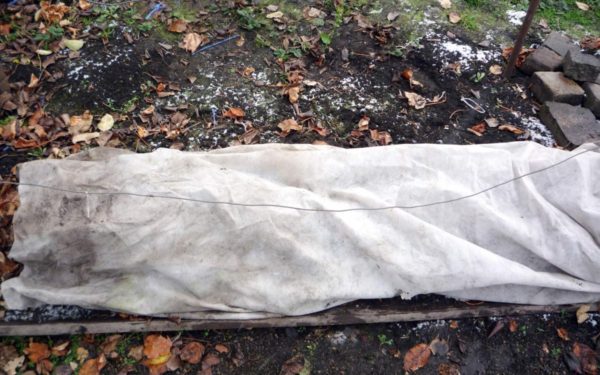
Ways to protect against mice and rodents
A vine laid close to the ground can be a treat for rodents, so it is important to protect and protect wintering grapes. Gardeners recommend choosing one of the following options.
-
-
-
- Mechanical traps are installed around the perimeter of fruit bushes to catch rodents. This may be the usual five-liter plastic containers or glass bottles, which add a little vegetable oil.
- Poisoning chemicals are the most effective pest control method. Among the popular: Difenacin, Brodifacoum, Flocumafen.
- Scarers are humane methods of rodent control. The bottom line is to establish around the perimeter of the shrub tanks with a specific substance, the scent of which scares away mice and rats. Among the famous smells: kerosene, Vishnevsky ointment, naphthalene, liquid smoke, etc., which will help to save the vines in the garden.
-
-
Judging by the listed recommendations, the preparatory work is not a difficult task, even a beginner can handle it. If you have questions, it is better to seek advice from specialists. They can not only explain, but also help warm the young grapes for wintering in the garden.
